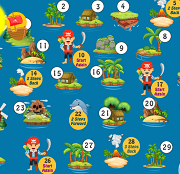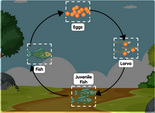Habitats and the Earthworm’s life cycle
This science game will help children learn and review knowledge about earthworms. Begin by reading all about earthworms below before playing the game.
Here's what you need to know about earthworms
Annelida is the phylum that includes the earthworm. This unique body plan is called a tube-within-tube. They have setae on every segment, and are both internally and externally divided. They can be found anywhere soil, temperature and moisture is suitable for their growth. Find out more about these amazing creatures! We hope that you find this informative article useful!
Earthworm life cycle
Earthworms must mate in order to have babies. Earthworms can sense each other when they touch and feel the ground. Then, they align their sex organs. They then transfer their sperm and eggs to each other when they mate. After they have mated, the worms will separate. The eggs and the sperm are then transferred into the clitellum, where they wiggle out to deposit their eggs. The juvenile earthworms grow up until they become adults. Their bodies are capable of repairing any damage they have suffered. Many earthworms are capable of repairing their damaged ends.
The earthworm's body is made up of several parts and is divided into two types. Anecic earthworms burrow into the soil and consume organic matter as well as excrete organomineral waste. Epigeic earthworms are soil-living and eat organic matter, which is in the form litter. They can grow to 10 feet in length and live in the mud near the banks of Rivers.
Although earthworms can live anywhere, they must have the right climate and quality of food. They may become dormant if the conditions aren't right. This is known as aestivation. This process is very similar to hibernation. This stage of the earthworm's life cycle is characterized by minimal movement. It is also when they develop their individual preferences. They will eat more organic material, such as leaves and grass.
About four to six weeks after hatching, the young earthworms emerge out of their cocoons. They are half an inch in length and white. They start eating once they come out of the cocoon. They can eat up to half of their body weight per day. Their first meal will consist of organic material. They can also eat up to five times as much. The environment they live in will determine their lifespan, but an average earthworm can live up to four to eight years. Most varieties only live for about one to two years.
When the clitella band around their bodies turns orange, the worms start mating. They eat half their body weight for most of their lives. To grip tunnel walls, they also have tiny bristles on the ends of their bodies.
The body of an earthworm is composed of many parts. Each segment is covered in tiny hairs called setae. There are also muscles that allow the body to move. As they move, they squeeze and relax. Earthworms are equipped with five hearts and a brain. They also have several other parts of their digestive system that allow them to breathe. They also have chemoreceptors, which help them detect soil chemicals. A large number of chemoreceptors are located close to their mouths.
Habitat for Earthworms
A few key elements make up an ideal habitat for earthworms. The earthworm's body, which is simple, depends on heat, humidity, and heat for survival. Although they do not have teeth, their chemoreceptors can detect temperature and odor. They also have a gizzard organ that can aid in digestion. The eyes and mouth of the worm are small, and its limbs can be moved easily.
The earthworm habitat aids in water purification and reduces surface water pollution. Their burrows aid in the reduction of organic matter and infiltration. Castings can also be used as soil conditioning materials or natural manures. They improve soil porosity and retention. These properties help to increase plant growth and decrease pest problems. Earthworms not only enrich the soil's richness, but also increase water infiltration, which aids plants to grow.
You must provide water, food and oxygen to create an ideal habitat for earthworms. Earthworms also require a certain temperature range. They don't need direct sunlight to stay warm but they do require a moderate temperature range. Earthworms, which are not able to produce their own temperature, prefer temperatures between 50 and 70 degrees Fahrenheit. While some species can tolerate lower temperatures, it is best to maintain a constant temperature. To prevent freezing, they will dig deeper into the soil in winter.
Each species has a different habitat. Some earthworms live at the surface while others live 20-25 cm below the surface. Others live as low as 3 meters below the surface. You can also find invasive species, such as tropical earthworms. Some earthworm species can be found in the tropics but most live on land. Although the soil is their main habitat, they also use compost bins to eat decayed plants. Decomposing leaves, fruits and seeds are also eaten by them. Earthworms also produce soil-based nutrients, which are beneficial for plants.
Earthworms are scavengers
Earthworms are a soft-slimy, invertebrates that have male and female characteristics. They eat organic matter from the soil and break it down into smaller pieces, as well as reusing the nutrients.
Earthworms and other soil organisms find the process of decomposition very beneficial. Earthworms eat dead leaves and organic matter, and break it down into small particles within their bodies. The soil becomes more fertile because of the minerals and other compounds in this waste. Earthworms are essential for soil health.
Earthworms are known to be decomposers in nature. They are decomposers, which means they break down organic matter and expel it as feces. They are mainly microorganisms that are responsible for many ecosystem nutrient cycle. Earthworms, in addition to being decomposers and scavengers, are also important. Although they look similar, these two types of animals serve very different purposes.
Earthworms are born when rain falls. They travel across the ground to mating sites. Then they join hands by pushing their anterior ends together.
You must first understand how earthworms move in order to study them as scavengers. They move in waves of relaxation and contraction. Protruding setae anchor their bodies to the substrate. Their bristles grab the substrate with their front ends. To push food out of their burrow, they retract their rear ends. They also retract their bristles at their back.
Morphology of earthworms
An earthworm's body is made up of different segments, each with a distinct function. The head has a mouth and strong jaws, called mandibles. Metameres are the other segments that have sets of muscles, nerve cords and blood vessels. The anterior part of the body experiences a wave of contraction and then moves backward. Fluid pushes the worm forward, while fluid moves backward.
An earthworm's body is cylindrical and long. It has a pointed dorsal and blunt posterior ends. The body is divided into sections measuring between 100 and 120mm in length, with the dorsal section containing dark blood vessels. The body is a crescentic tubular shape with a median dark line that indicates a blood vessel running the length of it. The segments of earthworms range from 100 to 120.
One pair of ovaries is found in the female earthworm. The funnel also contains an ovarian tube. The female genital pores are located below the ovaries. The ventro-lateral genital pore of a male earthworm is located on the 18th segment. The 14th segment has a crescentic female genital port. A ring of cilia separates the anal and mouth segments.
Reddish brown-colored earthworms are segmented, invertebrates. They are a segmented invertebrates that live in moist soil. Their pellets are known as earthworm castings. The earthworm is a friend to farmers, as they enhance soil fertility and help with aeration. There are about 6,000 species of earthworms.
Although the digestive systems of different earthworm species are different, the major areas of their digestive function are the exact same. There are two main parts to the digestive tract: the gizzard, and the mouth. These glands cover food particles to aid digestion. Saliva is responsible for breaking down enzymes and mucus found in foods. It has a highly developed respiratory system.
Earthworms have five hearts that run along their bloodstream. The blood flows from the poster to the anterior end of the body. It is reddish in color and contains hemoglobin. This pigment helps transport oxygen for respiration. It also contains fluid plasma and leukocytes, which are colorless blood corpuscles. The body's cells are phagocytic and the hemolymph of the heart is full of food particles.











